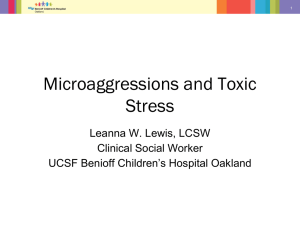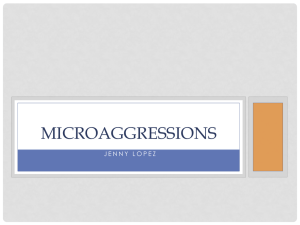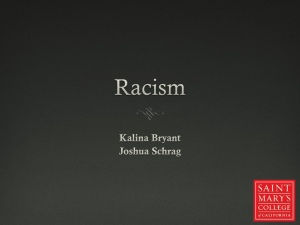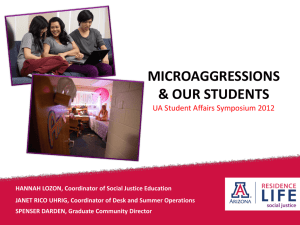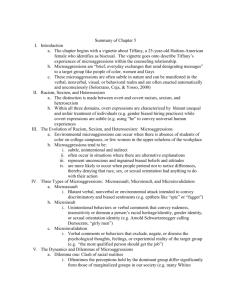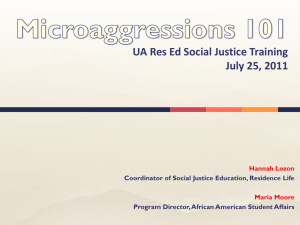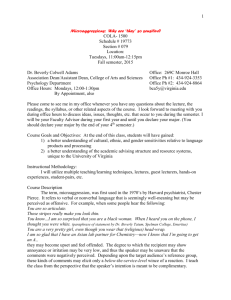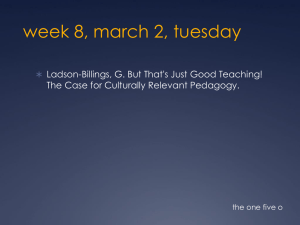File
advertisement
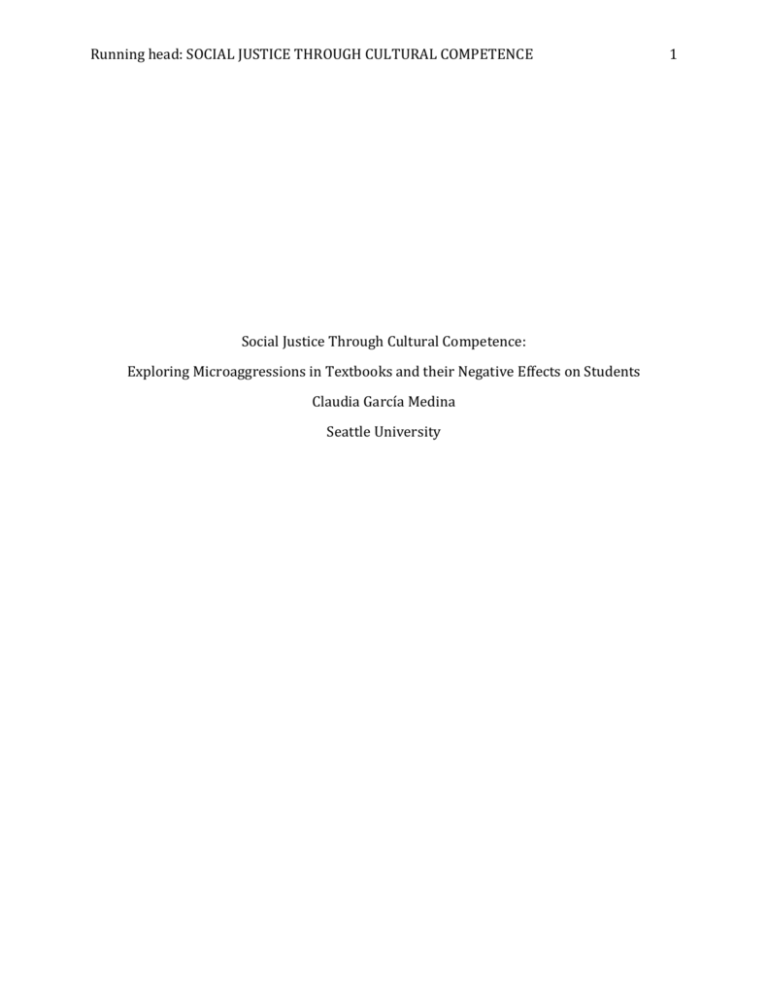
Running head: SOCIAL JUSTICE THROUGH CULTURAL COMPETENCE Social Justice Through Cultural Competence: Exploring Microaggressions in Textbooks and their Negative Effects on Students Claudia García Medina Seattle University 1 SOCIAL JUSTICE THROUGH CULTURAL COMPETENCE Abstract Social justice is a powerful term that reminds us all to keep the needs of others in the forefront of our minds. This paper embraces the concept of social justice in the classroom and argues that professors should utilize cultural competence as a framework when selecting classroom readings and textbooks. As classrooms become more diverse it is imperative that textbooks that contain microaggressions in their texts be eliminated from the classroom. By doing so, everyone in the classroom benefits, thus fostering graduating students who are culturally competent and hold social justice as their conceptual framework. Keywords: microaggressions, critical race theory 2 SOCIAL JUSTICE THROUGH CULTURAL COMPETENCE 3 As a first generation student of color, my experience in higher education has been both challenging and rewarding. The rewards by far outweigh the challenges; however, entering the classroom and feeling like I have to prove that I am intelligent enough to be in there is not only taxing but also very unjust. My feelings, concerns and experiences seem to be synonymous to those of other underrepresented students. Often, we do not feel that we are adequately included in the curriculum, required readings often leave us out of the content, and more often than not, if we are mentioned it is to provide a negative statistic or prognostic. College campuses are rapidly becoming more diverse. This diversification dramatically changes the campus climate and provides important opportunities for mutual learning, especially within the classroom. It is vital that professors are adequately prepared to facilitate difficult conversations in the classroom and that they understand the degree of damage microaggressions embedded in required readings cause. For the purposes of this paper I will draw from my experience as a student in the Student Development Administration program at Seattle University. I have identified microaggressions embedded in the required textbooks that have triggered me. What exactly is a microaggression? “Microaggressions are brief, everyday exchanges that send denigrating messages to people of color because they belong to a racial minority group… in the classroom, students may describe [them] as a pattern of being overlooked, underrepresented and devalued” (Sue & Constantine, 2007, p. 137). For those who do not belong to target groups, it may be difficult to identify microaggressions in their daily lives. It is even more difficult for them to identify microaggressions that are embedded in college textbooks. I acknowledge the fact that it is difficult to find textbooks that are SOCIAL JUSTICE THROUGH CULTURAL COMPETENCE 4 microaggression-free and also contain the content needed for the course. However, when such microaggressions are identified, it is imperative that healthy dialogue is initiated by the professor in order to address the transgressions. The challenge arises when the professor does not know how to foster a learning environment that supports, celebrates and validates the diverse cultural capital in the classroom. “We are hobbled by the paradox of a largely White teaching staff whose practices, consciously or not, contribute to the racial achievement gap yet who are unable to see what they are doing” (Taylor, 2009, p. 9). As Taylor suggests, White teaching staff are unable to see what they are doing, thus maintaining antiquated teaching practices in the classroom and utilizing the same textbooks that continue to publish microaggressions. The danger in utilizing textbooks that contain microaggressions is threefold; (1) it continues to support negative/hurtful stereotypes, (2) it is triggering to the target group, and (3) an opportunity to engage in important dialogue is lost. The majority of college professors are White and often times they fail to realize the privilege that comes with their whiteness. The problem is not that they have privilege but rather the lack of accepting their privilege. In the classroom (and in general in academia) white, upper-middle class, heterosexual males are the norm. In our, “radicalized society where whiteness is positioned as normative, everyone is ranked and categorized in relation to these points of opposition” (Ladson-Billings, 2009, p 19). Consequently, White students are awarded the privilege of being normal, and everyone else is left at the margins. The important point here is that professors hold power. They have the responsibility to foster a classroom environment that SOCIAL JUSTICE THROUGH CULTURAL COMPETENCE 5 is conducive to the educational success of all their students, regardless of their numerous identities. In a chapter about the mental wellness of students on college campuses, the authors introduced a very small section on ethnic diversity. They begin the section by acknowledging the diversification of college campuses and then go on to state: “Mental health professionals are faced with the challenges of assisting with the unique mental health issues of these various student populations” (Dunkle & Presley, 2009, p. 274). After making that statement, they go on to provide an example to support their point but utilize international students as their sample population. Not only did the authors state that students of color bring unique mental illnesses to college campuses, but they also compared domestic students of color to international students. This was triggering to me in numerous ways. What is more worrisome is that this was written in the primary textbook for future student affairs administrators. Essentially what we are being taught is that students of color have unique mental illnesses. Not only is it a microaggression, it also supports dangerous stereotypes. In another textbook, the author presented the topic of financial difficulties higher education institutions are enduring. These financial difficulties are causing programs to be cut and student funding to be decreased in additional to an increased presence of conservative ideas on higher education, and funds allocation. He states, “A third element of this resurgent conservatism, continuing at least into the second decade of the century, is increasing concern over crime and moral laxity, coupled with a diminishing inclination to view either poverty or racism as an acceptable excuse for ‘deviant’ (i.e., non-middle-class) SOCIAL JUSTICE THROUGH CULTURAL COMPETENCE 6 behavior (Johnstone, 2011, p. 318). I was so triggered after reading this sentence that I had to put the book down. Playing the race card is the last thing a person of color wants to be told when we voice our concerns. How dare the author even suggest that poverty and racism are synonymous to moral laxity? The message I extracted from this sentence was that people of color are immoral, poor and utilize such identities as crutches to justify bad behavior. That sentence was the end of the paragraph, leaving that as the final thought for the student reader. The same author states, “The future course of higher education’s quality, accessibility, and efficacy, from the vantage point of the second decade of the century, seems increasingly dependent on matters of finance” (Johnstone, 2011, p. 319). After being triggered by the aforementioned microaggression, I read this sentence and again was triggered. No, quality, accessibility and efficacy of higher education are not only about financial matters; we cannot continue to ignore the experiences of underrepresented students. Access continues to be about so much more than finances for underrepresented students. Once again the author does not go on to explain his thought process behind this statement and ends the paragraph with this sentence. The aforementioned are only a few examples of countless microaggressions that I have identified in our required classroom readings. In my own journey of trying to find my fit within the educational system, I stumbled across Critical Race Theory (CRT) and I automatically felt validated. “Critical race methodology in education…exposes deficitinformed research and methods that silence and distort the experiences of people of color and instead focuses on their racialized, gendered, and classed experiences as sources of SOCIAL JUSTICE THROUGH CULTURAL COMPETENCE 7 strength” (Solórzano & Yosso, 2009, p. 134). When I was reading academic work that honored my experiences as a student of color I finally felt like I belonged in academia; I found a sense of belonging. CRT offers underrepresented students the opportunity to share their experiences with their peers in an academic manner, without necessarily disclosing that this is their personal experience. It takes away the self-imposed responsibility of having to teach our peers all they need to know about students of color. Often underrepresented students take on the role of being the voices of their community because of a large void in the literature. If professors acknowledge the importance of addressing microaggressions and fostering a safe learning environment, the microaggressions will not be as devastating to the target groups. Holding conversations about diversity in the classroom can have the adverse affect of polarizing “student affairs graduate students and faculty rather than to clarify and increase mutual understanding about race relations” (Sue & Constantine, 2007, p. 142). This may be a reason why professors are intimidated by such conversations. However, the mutual growth, multicultural competence and personal development of all students will be increased if such dialogue is facilitated with proficiency. What can be done? “In dealing with racial stereotypes in our teacher education classrooms, we need to hear about, discuss, and analyze those racial experiences that People of Color and Whites encounter in their public and private worlds” (Solórzano, 1997, p. 11). Beginning the conversation is always difficult and very scary. It is almost easier to ignore the subject of microaggressions in textbooks because beginning the process of addressing such daunting subject matter is alien to most professors. Nevertheless, SOCIAL JUSTICE THROUGH CULTURAL COMPETENCE 8 “facilitating difficult dialogues in classroom settings may allow student affairs educators to avoid disastrous consequences (e.g., anger, hostility, silence, complaints, etc.) and improve inter-group relations” (Sue & Constantine, 2007, p. 139). The problem lies in the fact that by ignoring such microaggressions, we all turn into supporters of that system of oppression. When professors are courageous enough to create a classroom environment that not only fosters healthy dialogue, but also validates the experiences of those who have been traditionally oppressed and left out of textbooks, the professor becomes a change agent for all his/her students. This is what social justice looks like in the classroom. There is no doubt that student affairs professionals are being required to be innovative on how they interact and support students. The diversification of college campuses will continue to change student services for years to come. “Life was certainly much easier for student affairs professionals and faculty teaching student development when all we needed to learn and teach were the theories of Chickering, Perry, and Kohlberg” (Evans, Forney, Guido, Patton, & Renn, 2010, p. 20). However, not all students are being represented in these linear models. Students are more complex, vociferous and demanding than ever before. “Linear models are rigid and static, no longer reflecting the rhythms of daily postmodern life” (Evans, et. al., 2010, p. 372). College should be a place where student learning should be fostered. Stereotypes should be challenged and identities strengthened. This cannot happen unless we begin to engage in dialogue inside the classroom. Professors ultimately dictate the type of learning experience their students will have. A careful selection of textbooks and facilitating difficult dialogue is a great way to SOCIAL JUSTICE THROUGH CULTURAL COMPETENCE leverage the formation of all students. “We owe our students nothing less” (Evans, et. al., 2010, p. 372). 9 SOCIAL JUSTICE THROUGH CULTURAL COMPETENCE 10 References Dunkle, H. J., & Presley, C. A. (2009). Helping students with health and wellness issues. In G. S. McClellan & J. Stringer (Eds.), The handbook of student affairs administration (3rd ed.) (pp. 265-287). San Francisco: Jossey-Bass. Evans, N. J., Forney, D. S., Guido, F. M., Patton, L. D. & Renn, K. A. (2010). Student development in college: Theory, research, and practice (2nd ed.). San Francisco: Jossey-Bass. Johnstone, D. B. (2011). Financing higher education: Who should pay? In P. G. Altbach, P. J. Gumport & R. O. Berdahl (Eds.), American higher education in the twenty-first century: Social, political, and economic challenges (3rd ed.)(pp. 315-340). Baltimore: The Johns Hopkins University Press. Ladson-Billings, G. (2009). Just what is critical race theory and what’s it doing in a nice field like education? In E. Taylor, D. Gillborn, & G. Ladson-Billings. Foundations of Critical Race Theory in Education (pp. 17-36). New York and London: Routledge. Solórzano, D. G. (1997). Images and words that wound: Critical race theory, racial stereotyping and teacher education. Teacher Education Quarterly, Summer, 5-19. Solórzano, D. G. & Yosso, T. J. (2009). Critical race methodology: Counter-storytelling as an analytical framework for educational research. In E. Taylor, D. Gillborn, & G. Ladson-Billings. Foundations of Critical Race Theory in Education (131-147). New York and London: Routledge. SOCIAL JUSTICE THROUGH CULTURAL COMPETENCE 11 Sue, D. W. & Constantine, M. G. (2007). Racial microaggressions as instigators of difficult dialogues on race: Implications for student affairs educators and students. The College Student Affairs Journal, 26(2), 136-143. Taylor, E. (2009). Introduction. In E. Taylor, D. Gillborn, & G. Ladson-Billings. Foundations of Critical Race Theory in Education. (pp. 1-13). New York and London: Routledge.
